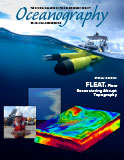Article Abstract
The wake created by the interaction of equatorial currents with the Palau islands generates small-scale vortices. We aim to identify the significant scales of this vortex wake by studying its structure and variability. We utilize a subkilometer resolution numerical model integrated from May 2016 through April 2017 that is nested within a 2.5 km state estimate hindcast model. The near-Palau flow is highly variable and has very different wake generation characteristics depending on whether the flow is westward or eastward. During westward flow, numerous strong vortices are generated at the northern tip of Velasco Reef and advected hundreds of kilometers to the northwest. During less frequent and less persistent eastward flow, transport develops through the Euchelel Ngeruangl and Kekerel Euchel channels that separate Velasco Reef from the main Palau island group. As this flow encounters the atoll of Kayangel in the channel, it splits and emerges to the east as vortices. During our 2016–2017 study period, these Kayangel eddies were ejected from the channel and advected southward along the eastern coast of Palau while being sheared laterally, and thus the wake did not have a large eastward extent. We find that wake eddies were not well resolved in the 2.5 km state estimate and that more numerous and intense eddies were simulated at higher resolution. Accurate simulations of the wake around such ocean obstructions therefore require subkilometer resolving models.

